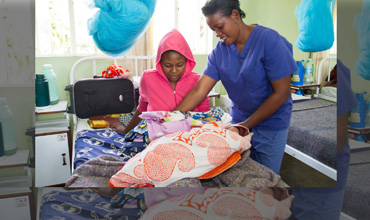Community Health Program on Increase of Male Involvement in Reproductive and Child Health Services at Haydom Lutheran Hospital Mbulu Manyara United Republic of Tanzania

Abstract:
Introduction: Male participation in child-bearing
decisions is crucial and also has a positive impact on the acceptability of PMTCT
interventions. Well-informed men will be more likely to participate positively in
the decision making for the well-being of the couple
There are reasons of involving men in reproductive health which are: expanding
the range of contraceptive options; supporting women’s contraceptive use preventing
the spread of sexually transmitted infections such as HIV/AIDS and to use the forum
of reproductive health programs to promote gender equity and the transformation
of men’s and women’s social roles
Statement of the problem: A study done in Magu district Shinyanga region
in Tanzania has showed that Male involvement in pregnancy and antenatal care in
Magu district is low. Barriers for male involvement included: traditional gender
roles, lack of knowledge, perceived low accessibility to join antenatal care visits
and previous negative experiences in health facilities. The data obtained at Reproductive
Health clinic at Haydom Lutheran Hospital shows that the number of male attended
for reproductive health services for the past six months i.e. January to June 2016
is 920 (18.7%), while the targeted population at this catchment area is 9798 per
year and 4899 per six months. As per this data it is obvious that male attendance
is low due to either inadequate education on the importance of attending RCHC. So
this program is done for the purpose of keeping aware men and the whole community
about the importance of their attendance to RCHC hence good number of clinic attendance.
Objectives: to increase the number of male involvement to RCH clinic services
at Haydom Lutheran Hospital
Program Stake holders: Health officers of all levels, Leaders and staff (HLH),
division, ward and village leaders, politicians, education officers who will be
involved in the program
Implementation of the program: During program implementation health education
was given to the community for five days with good attendance of 92 male and 420
female. Reasons for not attending to RCHS by men was obtained after interview to
20 men. The results was as follows: 12 (60%) men said that there was low attendance
due to sociological factors such as believes, attitudes, communication between men
and women followed by 4 (20%) who said it is due to lack of space to accommodate
partners So it shows that believes, attitude and communication plays major part
in the low attendance of men to RCHC.
References:
[1]. Asian-Pacific Resource
and Research Centre for Women. Men's roles and responsibilities in reproduction.
ARROWS For Change 1996 May; 2(1):1-12.
[2]. Aluisio A, Richardson BA, Bosire R, John-Stewart
G, Mbori-Ngacha D, Farquhar C. Male antenatal attendance and HIV testing are associated
with decreased infant HIV infection and increased HIV-free survival. J Acquir Immune
DeficSyndr. 2011; 56 (1):76–82. doi: 10.1097/QAI.0b013e3181fdb4c4. [PMC free article]
[PubMed] [Cross Ref]
[3]. Baiden F, Remes P, Baiden R, Williams
J, Hodgson A, Boelaert M, Buve A. voluntary counselling and HIV testing for pregnant
women in the Kassena-Nankana district of northern Ghana: is couple counselling the
way forward? AIDS Care. 2005; 17:648–657. doi: 10.1080/09540120412331319688. [PubMed]
[4]. Delvaux T, Elul B, Ndagije F, Munyana
E, Roberfroid D, Asiimwe A. Determinants of nonadherence to a single-dose nevirapine
regimen for the prevention of mother-to-child HIV transmission in Rwanda. J Acquir
Immune DeficSyndr. 2009; 50:223–230. doi: 10.1097/QAI.0b013e31819001a3. [PubMed]
[Cross Ref]
[5]. De Schacht C, Ismaël N, Santos I, Calú
N, Vubil A, Alons: HIV incidence during pregnancy and post-partum period in Southern
Mozambique: impact on vertical HIV transmission. 2011, Rome: 6th IAS Conference
on HIV Pathogenesis and Treatment and Prevention, Abstract no. MOPE124
[6]. De Paoli MM, Manongi R, Klepp KI: Factors
influencing acceptability of voluntary counselling and HIV-testing among pregnant
women in Northern Tanzania. AIDS Care. 2004, 16: 411-425. 10.1080/09540120410001683358.
View Article PubMed Google Scholar
[7]. Duff P, Kipp W, Wild TC, Rubaale T, Okech-Ojony
J. Barriers to male partner involvement in PMTCT programmes and HIV testing: a need
for more male-friendly services. Rome; 2011. (6th IAS Conference on HIV Pathogenesis
and Treatment and Prevention). Abstract no. CDC031.
[8]. Farquhar C, Kiarie JN, Richardson BA,
Kabura MN, John FN, Nduati RW, Mbori-Ngacha DA, John-Stewart GC. Antenatal couple
counselling increases uptake of interventions to prevent HIV-1 transmission. J Acquire
Immune DeficSyndr. 2004; 37:1620–1626. doi: 10.1097/00126334-200412150-00016. [PMC
free article] [PubMed] [Cross Ref]
[9]. Grady W et al., 1996, op. cit. (see reference
2); and D. Wilkinson, "Man-myths: some perceptions from Kenya: Reproductive
health attitudes and behaviour in three sub locations, unpublished paper, AVSC International,
New York, 1997.
[10]. Hartmann M, Gilles K, Shattuck D, Kerner
B, Guest G. Changes in couple’s communication as a result of a male-involvement
family planning intervention. J Health Commun. 2012; 17(7):802–819. doi: 10.1080/10810730.2011.650825.
[11]. https://www.gov.mb.ca/health/rha/docs/rolerha.pdf
[12]. https://www.nichd.nih.gov/health/topics/menshealth/
[13]. http://www.familycareintl.org
[14]. Katz DA, Kiarie JN, John-Stewart GC,
Richardson BA, John FN, Farquhar C: Male perspectives on incorporating men into
antenatal HIV counseling and testing. PLoS One. 2009, 4 (11): e7602-10.1371/journal.pone.0007602.
View Article PubMed Central Google Scholar
[15]. Kiarie JN, Kreiss JK, Richardson BA,
John-Stewart GC. Compliance with antiretroviral regimens to prevent perinatal HIV-1
transmission in Kenya. AIDS. 2003; 17:65–71. doi: 10.1097/00002030-200301030-00009.
[PMC free article] [PubMed] [Cross Ref]
[16]. Maman S, Mbwambo JK, Hogan NM, Weiss
E, Kilonzo GP, Sweat MD. High rates and positive outcomes of HIV-serostatus disclosure
to sexual partners: reasons for cautious optimism from a voluntary counselling and
testing clinic in Dar ES Salaam, Tanzania. AIDS Behav. 2003; 7:373–382. [PubMed]
[17]. Mswia R., Lewanga M et al, (2003). Community
Based Monitoring of Safe Motherhood in United Republic of Tanzania, WHO Bulletin
81:87-94.
[18]. Mlay R, Lugina H, Becker S. Couple counselling
and testing for HIV at antenatal clinics: views from men, women and counsellors.
AIDS Care. 2008; 20:356–360. doi: 10.1080/09540120701561304. [PubMed] [Cross Ref]
[19]. Painter TM, Diaby KL, Matia DM, Lin LS,
Sibailly TS, Kouassi MK, Ekpini ER, Roels TH, Wiktor SZ. Women’s reasons for not
participating in follow up visits before starting short course antiretroviral prophylaxis
for prevention of mother to child transmission of HIV: qualitative interview study.
BMJ. 2004; 329:543. doi: 10.1136/bmj.329.7465.543. [PMC free article] [PubMed] [Cross
Ref]
[20]. Semrau K, Kuhn L, Vwalika C, Kasonde
P, Sinkala M, Kankasa C, Shutes E Aldrovandi G, Thea DM. Women in couples antenatal
HIV counselling and testing are not more likely to report adverse social events.
AIDS. 2005; 19:603– 609. Doi 10.1097/01.aids.0000163937.07026.a0. [PMC free article]
[PubMed] [Cross Ref]
[21]. Semrau K, Kuhn L, Vwalika C, Kasonde
P, Sinkala M, Kankasa C, Shutes E, Aldrovandi G, Thea DM: Women in couples antenatal
HIV counselling and testing are not more likely to report adverse social events.
AIDS. 2005, 19: 603- 609. 10.1097/01.aids.0000163937.07026.a View Article PubMed
Central Google Scholar
[22]. Vermeulen, E., Solnes Milten Burg, A.
(2015), BMC Pregnency and Child birth. https://bmcpregnancychildbirth.biomedcentral.com
[23]. World Health Organization. WHO recommendations on health promotion interventions for maternal and newborn health. 2015:1–94.
[24]. Yargawa J, Leonardi-Bee J. Male involvement and maternal health outcomes: systematic review and meta-analysis. J Epidemiol Community Health. 2015;69(6):604–12. View Article PubMed Central Google Scholar

